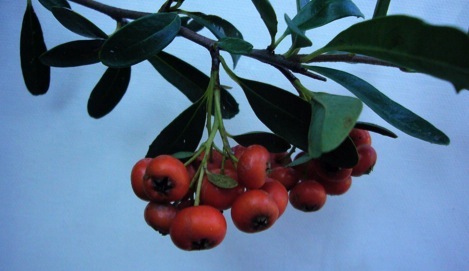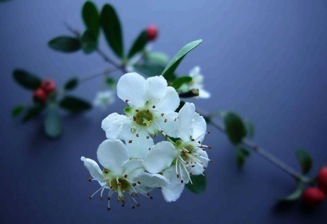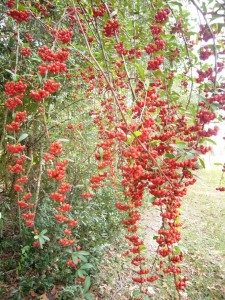
Pyracantha coccinea berries. Photo by Green Deane
Firethorn: Pyracantha Coccinea, a member of the Rose Family.
I don’t think it is a coincidence that “Ho Ho Ho” bellies and Pyracantha jelly jiggle into the season just before Thanksgiving.
While there is no explaining plump Santa, the Firethorn in Florida, Pyracantha coccinea, (pye-rha-KAN-tha cok-SIN-i-a) puts on its second crop of red berries about the same time the frozen Tom turkeys are being delivered to grocery stores. Firethorn’s two fruitings are thoughtful, feeding beast and man, spring and fall. Incidentally, Pyracantha comes from Greek and means literally “fire thorn.” Coccinea means scarlet.
A thorny evergreen, the Firethorn has been under Western cultivation since 1629 when it was first introduced into English gardens. Its native range is from southern Europe to the Caucasus Mountains. The Firethorn can make a very showy stand-alone small tree, a stunning hedge, an espalier to crawl along walls, or be potty trained as patio topic of preoccupation. It can also be a natural barrier grown outside windows that few trespassers would cross to get inside. You’ll also probably get a birds for entertainment because the species’ thorns keep predators of birds away.
Decades ago when I first saw the lanky Firethorn I asked about it and was told it was poisonous. “All red berries” the person said, “are poisonous.” That clearly is not true, nor is “all black berries are edible” true. These sayings are almost always wrong, but one, for practical purposes is close to true: Almost all white berries are toxic. There are a few white berries that are edible but they are so uncommon one might as well think all white berries are poisonous. Just avoid them

Firethorn blossoms resemble apple blossoms
There are references to Pyracantha as a famine food, and that might be true. However, the seeds, like the apple seeds, should not be eaten in quantity. My mother, who lived to 88, ate every seed of every apple she ever ate. She also ate the core as well: The entire apple was hers. When she is done there was nothing left. So a few apple seeds at a time appears to be fine. I asked her one time why she ate the entire apple. She said that’s what her mother did. Her mother also saved the seeds of virtually every fruit, dried them, cracked them and ate them, a few at a time. Back then they never heard of avocados or loquats, so don’t try it with those. However, loquat seeds, also in the Rose Family, can be used to make a cherry-flavored liquor. For that story, look at the article for Loquat Grappa.
The berries of the Firethorn — high in Vitamin C — are actually pommes which is a fleshy fruit with seeds at the core, like apples. They are greatly favored by Black Birds and Cedar Waxwings, which have been know to strip a tree of all its berries. To the human pallet, the berries are soft and mealy — like an apple that should have been eaten last week. They are mild flavor and have several seeds. The seeds are shaped like tiny angular Brazil nuts. Some report the berries are bitter but that has not been my experience. They are, however, sometimes slightly astringent. Like many soft berries they don’t keep well and that’s probably why they service man as jelly.
If you do any research on the internet for Pyracantha jelly you will find the following recipe:
Place 7 cups washed Pyracantha berries in a very large pan with 5 cups of water. Simmer uncovered for 20 minutes. Strain through a cloth. Measure 3 cups berry juice, 1/2 cup lemon juice and 7 cups sugar into a very large pan. Over high heat, bring to a boil, stirring constantly. Immediately stir in one bottle liquid pectin, bring to a full rolling boil and boil hard for one minute, stirring constantly. Remove from heat, skim off foam and pour into sterilized glasses. Cover With 1/8 inch melted paraffin. Prepared berry juice may be refrigerated or frozen prior to making jelly.
While that’s a good starting point I have not found it a satisfactory recipe. It produces an edible but weak-flavored jelly with anemic, runny texture. Here is what I do: I start with two quarts of cleaned and washed berries (no leaves, minimal bugs.) I boil them in six cups of water for at least 30 minutes. Then I mash the berries and cook for five minutes more. Strain. That gives you six or so cups of infusion. I put that in a new pot and bring to boil. I premix eight cups of sugar with TWO — not one — but TWO packages of Sure Jell (twice the standard portion in other words) and I add one half teaspoon of citric acid. A half cup of lemon juice also works but I like to thoroughly mix my dry ingredients together ahead of time. It reduces clumping. Once the infusion is boiling, I add the dry mixture and then bring to boil again and boil for two minutes. This will make 12 to 13 cups of jelly. Then I can it the usual way using sterilized jars and paraffin. I haven’t tried it but I am tempted sometime to add a teaspoon of cinnamon to the infusion because the jelly has a hint of apple flavor. Here’s my video link to making Firethorn sauce: http://www.youtube.com/watch?v=obZkfO3tKt0
Of course, making Firethorn jelly is more than just making jelly. While there have been many changes since the days of our grandparents, or great grandparents, one of them is we have become removed from the dynamic of food. Ask kids where milk comes from and too many will say a bottle. Food is the intimate link between us and the earth and in our preprocessed, prepackaged world we lose a bit of our grounding when everything comes off a shelf, or worse, out the drive-in window. It is surprising how many of us actually don’t eat much food these days but rather preprocessed food substitutes that proudly state what has been removed. When you identify a fruit grown by nature, not man; harvest it, prepare it, and then let it help sustain your life, you realize you are part of this planet and very dependent upon it. I would also add our ancestors got along quite well without nutritionists or botanists. Fortunately, artificial food has been around less than a century. If the ingredients reads like a chemistry set, you might want to consider not eating it.
One of my grandfathers who lived into his high 80s liked two things and had them nearly every day of his adult life: A pint of cream and a piece of homemade jelly roll. Owning a succession of cows took care of the cream, and my grandmother was constantly making jelly and jam out of most conceivable and inconceivable things: Hawthorn jelly, Chokecherry jelly, and Gooseberry jam come to mind. I think she even made tomato jelly (and why not? After all, tomatoes are actually fruits, not vegetables.) Besides putting a little nature in one’s life, jellies and jams that you can’t buy can be come seasonal events, family traditions and tastes that last from generation to generation. I can hardly wait until spring to make pindo palm jelly.
Pyracantha Sauce
by Green Deane
EatTheWeeds.com
3 pints ripe pyracantha pommes
Water to cover
Juice and zest of one lime
One (or more) minced chipotle pepper in adobo sauce
Sugar to taste
Two tablespoons corn starch
Salt optional
Put whole pommes and water in a sauce pan, bring to a boil, lower to a simmer and simmer for 30 minutes, mash. Add lime juice, zest, and chipotle pepper, simmer 30 more minutes. Filter the liquid, discarding all solids. Reserve 1/2 cup liquid. By simmering again reduce liquid down to about two cups. Taste. Add sugar to desired taste. Mix the corn starch in the now cool reserve liquid then mix that a little at a time into the sweetened sauce until thick. Use or refrigerate.
Green Deane’s “Itemized” Plant Profile
IDENTIFICATION: Thorny evergreen shrubs with serrated leaf margins and numerous thorns. They have white flowers and either red, orange, or yellow berries.
TIME OF YEAR: In northern climates the flowers come out in late spring and early summer; the berries develop from late summer, and mature in late autumn. In Florida this happens in spring and fall, sometimes continuously throughout the year.
ENVIRONMENT: Not particular about soil, refers full sun but will grow in partial shade. A common landscape plant
METHOD OF PREPARATION: Berries can be used for jelly. They can also be used for a sauce, marmalade, wine and extender. The seeds are not edible in quantities more than a few.


